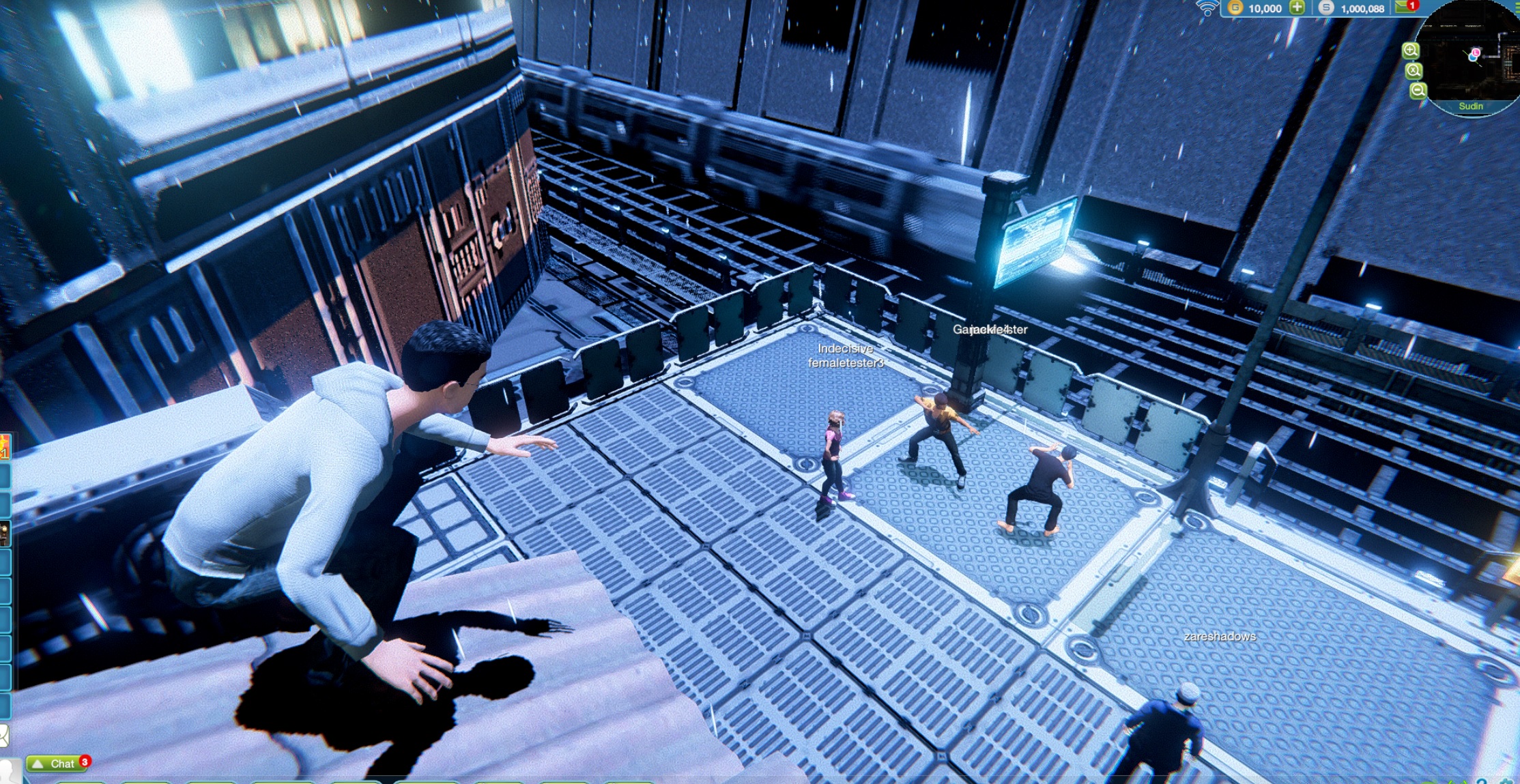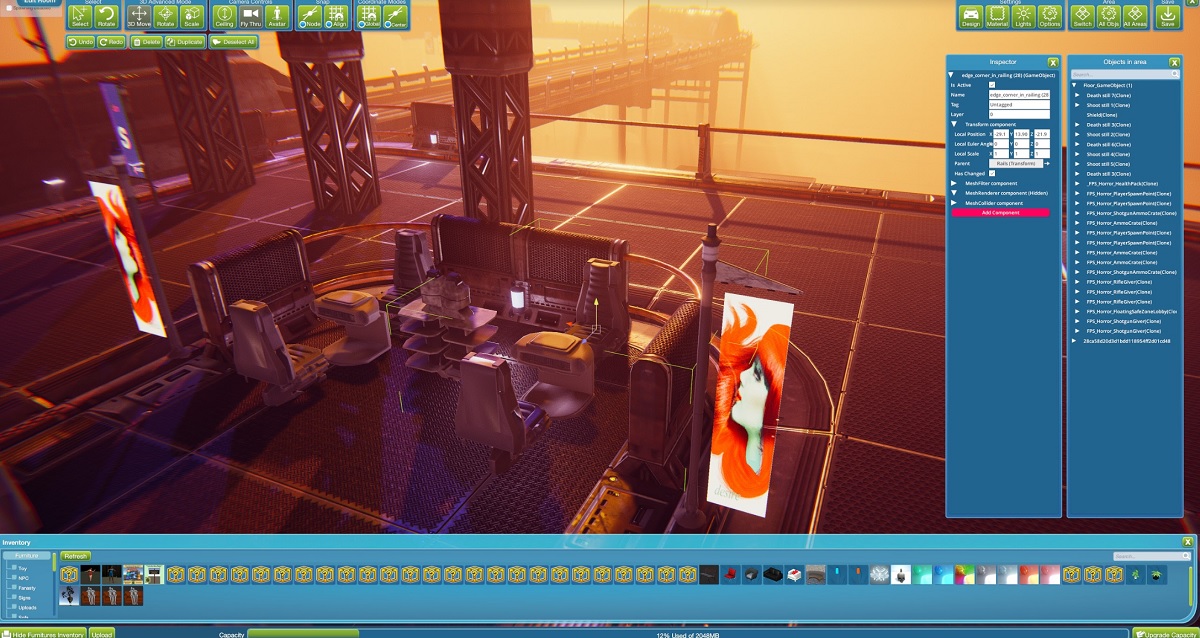Sinespace maker Sine Wave Entertainment has teamed up with Unity Technologies to make its virtual reality marketplace objects available via a software development kit (SDK) in the Unity Asset Store. The Sinespace assets are do-it-yourself items sold within the virtual world.
Sinespace unveiled its Sinespace software development kit (SDK) in the Unity Asset Store at the Game Developers Conference. It will also launch a first-person shooter level design contest at Unity parties on Tuesday and Thursday. Unity makes one of the most popular video game engines
This is all part of Sinespace’s bid to outdo Linden Lab, which created the memorable virtual world Second Life in 2003, in virtual reality. But even as Linden Lab tries to create its Sansar virtual spaces for VR, Sinespace has emerged to be the place for do-it-yourself creators in VR.
Fortnite’s success shows the huge market for online worlds which combine multiplayer gaming with virtual world-type experiences (avatar enhancements, customizable islands, live dance parties & music ala Marshmello). In other words, we finally have a market for Ready Player One-type open game worlds.
June 5th: The AI Audit in NYC
Join us next week in NYC to engage with top executive leaders, delving into strategies for auditing AI models to ensure fairness, optimal performance, and ethical compliance across diverse organizations. Secure your attendance for this exclusive invite-only event.
Sinespace is billing itself as a massively multiplayer online sandbox world in VR, and the company launched in November its Certified Creators program to try to boost the creation of user-generated content in Sinespace. It hopes that it can stand out from others because its technology won’t be “pinned in time,” but rather will change with the times as graphics and other technologies move forward.
The company has been working on its Unity-based tech since 2010, and it is aiming to extend compatibility and improve its graphics over the long term. The world has had five major updates during the intervening years. In the world, you can create, chat, interact, and play. You can show off in a welcome area, or move along to your own 3D spaces.
Adam Frisby, founder, said that Sine Wave Entertainment’s monthly active users grew from 10,000 in June 2018 to more than 50,000 now. And those players are spending an average of $22 a month on virtual content, compared to $17 a month in June 2018. 
Sinespace has gone through five major updates. People have uploaded thousands of virtual items, such as clothing or furniture. They are all for sale in the in-game store. Top-selling items so far are avatar clothing, gestures, and houseware items.
Frisby pointed out that while copyright infringement runs rampant on other virtual worlds (ripped copies of video game and cartoon characters, etc.), Sinespace’s Certified Creators program is designed to respect intellectual property rights.
Under the new program, Certified Creators will be able to publish and sell their content in Sinespace instantly, without prior review by the Sinespace content team.

Above: Sinespace lets users create their own content in VR.
In an August 2018 survey of the Sinespace community, the most popular items to buy in the shop were shirts, pants, and hair. The community also expressed interest in seeing more items in the shop to choose from — especially customized avatar eyes and bodies, along with dresses and shoes. Like in other worlds, users can carve out a virtual space and customize it as they wish, creating places with racetracks or waterfalls.
Frisby has been building the world quietly since 2010, and now 20 people are working on it. The company survived by creating virtual worlds and running them for other parties. It has learned how to make sure the world runs well, even on low bandwidth. Sinespace has some older elements that date back to 2009, and those elements are still working in the current world, Frisby said.
Frisby has been working on virtual worlds since Active Worlds in 1996. Those worlds weren’t that good, or at least didn’t have mass appeal, Frisby said.
When Second Life emerged in 2003, it got a much larger audience, hitting tens of millions of registered accounts over the next decade or so. Frisby was one of the original creators in Second Life, and he was pulling in revenues of seven figures.
The Sinespace SDK is an all-in-one “virtual world for Unity” SDK for developing & publishing AAA-quality multiplayer games & apps in a shared open world platform that unites the entire development process to a growing consumer base and a virtual currency system with a real money cash-out option for developers.
“We’re so proud and thrilled to bring our Sinespace SDK to the Unity community,” said Adam Frisby. “After twenty years in the industry, I believe this is the beginning of a metaverse that’s worthy of the name.”
With the Sinespace SDK, Unity developers can create new games and market them to Sinespace’s fast-growing player base — or use the SDK’s white label option to launch them as standalone multiplayer games.

Above: Sinespace is making it easy to build virtual worlds.
The Sinespace SDK includes key features for rapidly creating AAA-quality games, including Build Kill Repeat, an open source, fully modifiable combat system, and content from top Unity vendors and Sinespace partners Dexsoft-Games (3D Models-Textures), Gaia, and Archimatix.
The Sinespace SDK instantly optimizes 3D experiences for play on PC, Mac, Linux, Oculus, Vive, Android and WebGL. (Support for iOS and consoles coming soon.) Unlike other open game worlds, Sinespace is architected to fully update all content with every Unity update.
Developers can upload and sell assets from their existing single-player games — or use them in new multiplayer titles. For instance, when Warren Spector made a special guest appearance in Sinespace, his team uploaded 3D models from his latest Unity game into Sinespace.
“I’ve been developing virtual worlds since I was 12,” Frisby said. “Twenty years later, I believe this is finally the start of a metaverse worthy of the name.”

